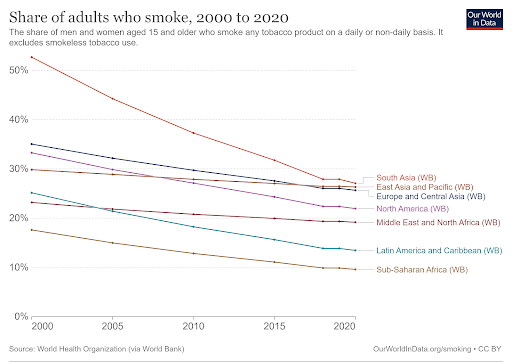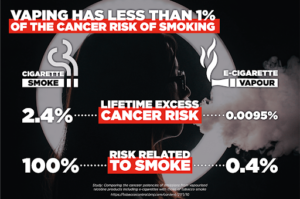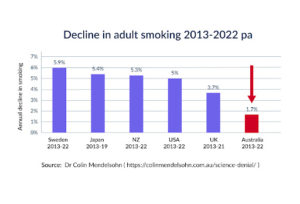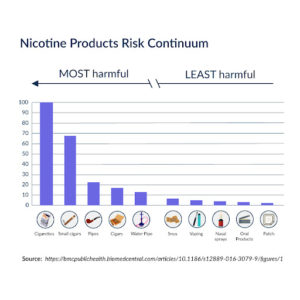Fumatul este o problemă globală. Există aproximativ 1,3 miliarde de consumatori de tutun în lume. Până în prezent, abordările tradiționale de renunțare la fumat s-au dovedit a fi extrem de ineficiente. De la lansarea produselor alternative la fumat pe bază de nicotină, am observat progrese uriașe în reducerea ratelor de fumat la nivel mondial. De exemplu, Suedia, o țară cu o lungă tradiție în promovarea snusului, dar și a plicurilor cu nicotină și a vapingului, este celebrată ca fiind prima țară din lume care a devenit o țară fără fum de tutun. Regatul Unit și-a redus ratele de fumat cu aproape 50% între momentul în care vapatul a fost aprobat de către Public Health England în 2015 și 2021., lansează acum un program la nivel național pentru a încuraja fumătorii să renunțe la țigări, înlocuindu-le cu o țigară electronică gratuită. Reducerea riscurilor s-a dovedit a fi o forță motrice în lupta globală împotriva fumatului.

Această fișă informativă își propune să elucideze problema reducerii daunelor provocate de vaping și tutun, oferind o imagine de ansamblu cuprinzătoare asupra celor mai relevante și actualizate cercetări științifice și politici de reglementare din întreaga lume.
Ce este reducerea riscurilor?
Reducerea riscurilor își propune să minimizeze impactul negativ al unei activități. La fel cum centurile de siguranță și căștile sporesc siguranța în timpul conducerii, reducerea riscurilor caută soluții practice în detrimentul idealurilor nerealiste. Prioritizează modalități fezabile de atenuare eficientă a riscurilor.
De ce este vapatul o metodă care reduce riscul?
În ceea ce privește reducerea daunelor provocate de tutun, vapatul se remarcă ca un exemplu excelent. Deși abstinența completă poate fi ceea ce aspiră unii consumatori, aceasta este adesea imposibil de atins. Având în vedere cererea largă de nicotină, evidențiată de existența a milioane de fumători, vapatul oferă o modalitate de a decupla consumul de nicotină de cele mai dăunătoare aspecte ale fumatului. Deși nu este complet lipsit de riscuri, vapatul reduce semnificativ daunele în comparație cu fumatul, ceea ce îl face o alternativă valoroasă pentru fumătorii care doresc să își atenueze riscul personal.
Este vapatul mai puțin dăunător decât fumatul?
Da. Sunt mult peste 100 de organizații și instituții guvernamentale care sunt de acord că vapatul este mai puțin dăunător decât fumatul.
Vapatul ajută fumătorii să se lase?
Da. O nouă analiză sistematică a dovezilor, inclusiv 78 de studii finalizate de către Organizația Neguvernamentală pentru Sănătate Publică din Marea Britanie, Cochrane, a confirmat că vapatul îi ajută pe fumători să renunțe. Recenziile sistematice ale Cochrane sunt recunoscute la nivel global ca standardul de aur în dovezile privind sănătatea.
Cum ar trebui reglementat vapatul?
Ceea ce ne trebuie este un reglementare bazată pe risc. Vapatul este mai puțin dăunător decât fumatul.
și nu trebuie tratate în același mod. Alternativele mai puțin dăunătoare ar trebui să fie mai puțin reglementate decât cel mai dăunător produs de pe piață - țigările.
Mai jos sunt prezentate cele mai relevante studii compilate în următoarele domenii:
Fiecare capitol include o secțiune de referințe la final, unde sunt compilate toate articolele academice citate.
Cercetările au demonstrat că, deși nu este complet inofensiv, vapatul este mult mai puțin dăunător decât fumatul. Riscul de cancer în comparație cu fumatul este practic inexistent. Iată principalele dovezi despre efectele asupra sănătății ale vapatului în comparație cu fumatul:

Există suficiente dovezi pentru a concluziona nu doar că vapatul ajută la renunțarea la fumat, ci și că este unul dintre cele mai eficiente instrumente pentru a face acest lucru. Vapatul este o... recomandat mijloace de renunțare la fumat pentru fumători Franţa, cel/cea/cei/cele Regatul Unit, Canada, și Noua Zeelandă; și a fost esențială în reducerea ratelor de fumat în țările care au o abordare bazată pe dovezi în acest sens, cum ar fi în Regatul Unit, unde fumatul este la un nivel minim istoric. Iată principala cercetare:

Până în prezent, vapatul este cel mai eficient ajutor pentru renunțarea la fumat, așa cum a concluzionat ONG-ul din domeniul sănătății Cochrane, foarte apreciat, în ultima sa meta-analiză realizată de Lindson și colab. (2023).
Vapatul ca o poartă de acces pentru adolescenți către fumat este unul dintre cele mai îngrijorătoare mituri în domeniul controlului tutunului. Cu toate acestea, există puține sau deloc dovezi care să stabilească o legătură între vapatul în rândul tinerilor și fumatul convențional. Există multe... alte motive pentru care tinerii fumează. Să aruncăm o privire la ce a putut demonstra știința:
Pe lângă lipsa dovezilor care leagă vapatul în rândul tinerilor de fumat, datele arată că atât rata fumatului, cât și cea a vapatului în rândul tinerilor au scăzut în multe țări în ultimii ani. Datele de la Action on Smoking and Health (ASH) UK arată că Ratele fumatului în rândul tinerilor sunt la un nivel minim istoric și date de la Oficiul Național de Statistică arată că vapingul în rândul tinerilor este rar în rândul celor care nu au fumat niciodată. Majoritatea utilizatorilor sunt fumători actuali sau foști fumători. În SUA, unde auzim des despre așa-numita “epidemie de vaping”, vapingul în rândul tinerilor a căzut semnificativ în ultimii ani.
Prof. Polosa și colab. (2022)²⁵ a rezumat modelul de utilizare a țigărilor electronice în rândul tinerilor astfel: “Utilizarea contraceptivelor electronice (EC) a crescut considerabil în rândul elevilor de liceu și al tinerilor adulți în ultimul deceniu, dar, din fericire, a scăzut semnificativ de la vârful atins în 2019. În aceeași perioadă, ratele de fumat au scăzut constant la noi niveluri record. Aceste tendințe contrazic utilizarea EC ca poartă de acces către fumat. Utilizarea EC este în mare parte rară și este puțin probabil să crească riscul unei persoane de consecințe negative asupra sănătății. În plus, majoritatea utilizării EC a avut loc în rândul celor care au fumat anterior.” Nu se întrevede niciun efect de poartă de acces.
Aromele sunt unul dintre cele mai controversate subiecte în ceea ce privește politica publică privind vapatul. Se crede în general că aromele sunt destinate adolescenților și sunt rareori folosite de adulți. Cu toate acestea, numeroase cercetări au stabilit importanța lor pentru adulții care încearcă să renunțe la țigări electronice și există dovezi ample că interdicțiile privind aromele fac mai mult rău decât bine.
Iată dovezile despre aromele de vapat:
Friedman și Xu (2020),Cercetătorii de la Școala de Sănătate Publică Yale au asociat utilizarea aromelor de vapat cu o creștere a probabilității de renunțare la fumat la adulți și au concluzionat că: “Adulții care au vapat țigări electronice aromate au fost mai predispuși să renunțe ulterior la fumat decât cei care au folosit țigări electronice fără aromă. (...) Adulții care au început să vapete țigări electronice fără aromă de tutun au fost mai predispuși să renunțe la fumat decât cei care au vapat arome de tutun.”
Mendelsohn (2017),Într-o prezentare adresată unui comitet al Camerei Reprezentanților din Australia, ,²⁷ a afirmat că aromele sunt mai susceptibile de a-i ține pe oameni departe de țigările tradiționale, deoarece îi ajută să uite aroma tutunului: “Aromele reprezintă o parte importantă a atractivității țigărilor electronice pentru fumătorii adulți și fac produsele atractive ca alternativă la fumat, la fel cum aromele sunt folosite și pentru a spori atractivitatea gumei de mestecat cu nicotină. Interzicerea aromelor ar submina probabil utilizarea țigărilor electronice și sănătatea publică.”
Friedman (2020)²⁸ a analizat efectele interdicției privind aromele în San Francisco și a constatat că aceasta a dus la creșterea ratei fumatului în rândul adolescenților, pentru prima dată în ultimele decenii.
Bogat (2022)²⁹ a analizat efectele interdicției privind aromele în Massachusetts și a concluzionat că aceasta a dus la creșterea vânzărilor de țigări.
Gravely și colab. (2020)³⁰ a realizat un sondaj în rândul utilizatorilor de arome de vapat, altele decât cele din tutun, din Canada, Regatul Unit și Statele Unite și a constatat că, în cazul unei interdicții aromelor, 5 din 10 și-ar procura aromele de pe piața secundară sau ar relua fumatul.
The Fundația Tholos (2022)³¹ a analizat efectele interdicției aromelor în Estonia și a constatat că 60% dintre utilizatorii de țigări electronice au continuat să le folosească, amestecându-și propriile lichide sau obținându-le de pe piața neagră.
Friedman şi colab. (2023)³² au studiat restricțiile privind ENDS aromate în Statele Unite și au estimat un compromis de 15 țigări suplimentare pentru fiecare capsulă ENDS de 0,7 ml mai puțin vândută din cauza restricțiilor privind aromele ENDS. Autorii au concluzionat că “Orice beneficii pentru sănătatea publică generate de reducerea utilizării dispozitivelor endocrinologice speciale (ENDS) prin restricții privind aromele pot fi compensate de costurile pentru sănătatea publică generate de creșterea vânzărilor de țigări.”
Pe măsură ce Scheer al UE (2021) Raportul a concluzionat: “Până în prezent, nu există date specifice care să ateste că anumite arome utilizate în UE prezintă riscuri pentru sănătatea utilizatorilor de țigări electronice în urma expunerii repetate.”
Mulți factori de decizie politică consideră că taxele pe sistemele electronice de administrare a nicotinei (ENDS) sunt un instrument capabil să reducă utilizarea țigărilor electronice și să îmbunătățească sănătatea publică. Indiferent de situație, majoritatea dovezilor arată că creșterile de taxe pe țigările electronice îi determină pe utilizatori să reînceapă să fumeze.
Taxele pe produsele alternative ar trebui stabilite în funcție de riscul lor relativ la cel al țigărilor. Din punct de vedere al stimulentelor, nu are sens să se impoziteze țigările tradiționale și cele electronice în același mod. Taxele pe țigările tradiționale sunt menite să acopere costurile asistenței medicale și externalitățile negative derivate din fumat. Întrucât vapatul este mai puțin dăunător pentru utilizator și nu are efecte negative asupra celor din jurul său, este doar proporțional ca taxele să fie și ele mai mici. Acest lucru nu numai că va fi suficient pentru a acoperi costurile asistenței medicale derivate din vapat, dar diferența de preț față de țigările tradiționale va fi încă un stimulent pentru fumători să treacă la țigări și să își îmbunătățească sănătatea publică și propria sănătate.
Se crede în general că nicotina este dăunătoare, iar ideea că vapatul produselor cu nicotină provoacă cancer este la fel de răspândită. Prin urmare, se susține adesea că vapatul cu nicotină este la fel de dăunător ca fumatul. În ciuda faptului că vaporii de țigară electronică nu conțin cele mai nocive elemente din fumul de tutun, cum ar fi gudronul sau monoxidul de carbon, se crede că totuși provoacă cancer. Cu toate acestea, nicotina s-a dovedit a fi relativ inofensivă:
Gheorghe (2019)³⁹ a studiat efectele cardiovasculare ale trecerii de la fumat la vaping și a constatat că cei care trec de la fumat își îmbunătățesc sănătatea, indiferent dacă continuă să consume nicotină sau nu.
Foulds și colab. (2021)⁴⁰ au descoperit că nicotina este un factor important în capacitatea fumătorilor de a trece la țigara electronică. Autorii au descoperit că vapatul “cu o eliberare de nicotină apropiată de cea a unei țigări, sunt mai eficiente în a ajuta fumătorii ambivalenți să renunțe la fumatul de țigări.”
Niaura (2016)⁴¹ a declarat că “”Cea mai mare parte a daunelor fiziologice atribuibile fumatului de țigări provine din substanțele toxice din tutun și produsele de ardere. Morbiditatea și mortalitatea prevenibile au fost în mare parte legate de fumatul tutunului ars, nu de nicotină în sine. Decuplată de ardere sau de alte moduri toxice de administrare, nicotina, în sine, este mult mai puțin dăunătoare.”
Opinia că nicotina nu este componenta nocivă din produsele din tutun a fost susținută de mai multe organizații de sănătate. Marea Britanie Serviciul Național de Sănătate, urmând o abordare pragmatică a consumului de nicotină și a vapatului, a declarat că: “Deși nicotina este substanța care dă dependență în țigări, este relativ inofensivă. Aproape toate efectele nocive ale fumatului provin din miile de alte substanțe chimice din fumul de tutun, multe dintre ele fiind toxice.”
În mod similar, Cercetarea Cancerului în Yorkshire a declarat: “Nicotina nu este cauza decesului cauzat de fumat. Nicotina nu este cancerigenă; nu există dovezi că utilizarea susținută a nicotinei singure crește riscul de cancer. Dintre cele trei cauze principale de deces cauzate de fumat (cancerul pulmonar, boala pulmonară obstructivă cronică și bolile cardiovasculare), niciuna nu este cauzată de nicotină. Daunele provocate de fumat provin din miile de alte substanțe chimice din fumul de tutun.”
Shirley Cramer, directoarea executivă a Societății Regale pentru Sănătate Publică, a spus: “Convingerea oamenilor să consume nicotină în loc să consume tutun ar face o mare diferență pentru sănătatea publică – în mod evident, există probleme legate de dependența fumătorilor de nicotină, dar acest lucru ne-ar ajuta să nu mai avem o problemă gravă și costisitoare de sănătate publică, de la bolile legate de fumat la…” abordează în schimb problema dependenței de o substanță care, în sine, nu este prea diferită de dependența de cofeină.”
Snus:
Snusul este o pungă de tutun pudră umedă, fără fum, originară din Suedia, care se folosește prin plasarea acesteia sub marginea superioară. Utilizarea snusului a depășit fumatul țigărilor combustibile în Suedia. Suedia este pe cale să devină prima țară care atinge obiectivul de a fi fără fum de tutun, cu o rată actuală a fumatului de 5,6%. Chiar dacă consumul total de nicotină în Suedia se încadrează într-un interval similar cu cel al altor țări europene, mortalitatea legată de fumat este mult mai mică, după cum demonstrează... Clarke și colab. (2019).⁴²
Informații cheie:
Pliculețe cu nicotină:
Pliculețele cu nicotină sunt cea mai nouă alternativă la fumat și, prin urmare, nu sunt încă reglementate în mod adecvat în multe țări. Pliculețele cu nicotină sunt utilizate similar cu snusul, dar spre deosebire de snus, conțin o pudră de nicotină în loc de o frunză de tutun. În prezent, acestea sunt fie nereglementate, fie complet interzise, fie tratate la fel ca țigările în majoritatea țărilor - și niciuna dintre aceste alternative nu este optimă. Cu o reglementare favorabilă consumatorilor, pliculețele cu nicotină ar putea fi o piatră de temelie a marșului nostru către populații fără fum de tutun.
Informații cheie:
Produsele alternative pe bază de nicotină au potențialul de a reduce ratele de fumat și de a îmbunătăți sănătatea publică. Dovada acestui fapt este faptul că țările cu un grad relativ ridicat de adoptare a produselor alternative pe bază de nicotină, cum ar fi vaping-ul, tutunul încălzit, pliculețele cu nicotină și snus-ul, reduc în general ratele de fumat mai rapid decât țările care se abțin de la acestea. Regatul Unit și Suedia demonstrează că se pot obține rate mai mici de fumat printr-o abordare deschisă față de produsele alternative pe bază de nicotină.
Regatul Unit: ajutor pentru fumători la schimbarea stilului de viață
Regatul Unit este cea mai progresistă țară din lume când vine vorba de vaping. Guvernul și instituțiile de sănătate publică susțin pe deplin vapingul ca instrument de reducere a riscurilor, iar fumătorii sunt încurajați să treacă la această alternativă mai puțin dăunătoare. În Regatul Unit, Ratele fumatului au scăzut cu peste 29% în ultimul deceniu (când vapatul a devenit popular). Comparativ cu UE, ratele fumatului în Regatul Unit au scăzut de două ori mai repede, potrivit Fagerström (2022).Anul acesta, Regatul Unit a lansat ‘Swap-to-Stop’, cea mai mare strategie de renunțare la fumat susținută de guvern de până acum, care utilizează țigări electronice.
Suedia: devine prima țară fără fumat cu ajutorul snusului
În Suedia, consumul de snus a depășit fumatul țigărilor combustibile, în principal datorită trecerii fumătorilor la acesta. Datorită înlocuirii tutunului cu această alternativă mai sigură, Suedia este pe cale să devină prima țară care atinge obiectivul de a rămâne fără fum de tutun, cu o rată a fumatului de 5,6% începând cu 2023. Chiar dacă consumul total de nicotină în Suedia se încadrează într-un interval similar cu cel al vecinilor săi europeni, mortalitatea legată de fumat este mult mai mică, după cum arată... Clarke și colab. (2019),⁴⁷ dovedind că snusul este un produs mult mai puțin dăunător, care poate îmbunătăți sănătatea publică în general. Suedia dorește acum să accelereze acest proces prin reducerea taxei pe snus până în 20%.
Japonia: produsele care nu încălzesc, nu ard, reduc ratele fumatului
Produsele care nu se încălzesc (HnB) încălzesc tutunul și creează un aerosol inhalabil în loc să-l ardă, ca țigările tradiționale. Simonavicius și colab. (2019) s-a constatat că lipsa combustiei le face considerabil mai sigure decât țigările tradiționale.⁴⁸ Datorită introducerii și popularizării lor în Japonia, în doar cinci ani (2016-2021), vânzările de țigări au scăzut vertiginos cu 4,31% din populația japoneză. Tot mai mulți japonezi resping țigările și aleg produse alternative mai puțin dăunătoare, cum ar fi „încălzește, nu arde”. Rata HnB în Japonia este în prezent de aproximativ 4,51% din populația cu BPA, iar Sondajul privind sănătatea și nutriția a constatat că 761% dintre utilizatorii de HnB nu mai fumau deloc țigări.
Noua Zeelandă: conștientizarea fumătorilor cu privire la alternativele mai sigure
Furnizarea de informații precise despre produsele alternative pentru fumători îi poate ajuta să ia decizii mai bune și să își îmbunătățească sănătatea. Ministerul Sănătății din Noua Zeelandă este cel mai bun exemplu de comunicare despre vaping. Site-ul web VapingFacts, susținut și de majoritatea organizațiilor de sănătate publică din Noua Zeelandă, oferă informații precise despre sănătate, sfaturi pentru renunțarea la fumat, o linie telefonică de asistență și oportunități de asistență personală. În timp ce alte țări răspândesc dezinformare și ignoră cercetările ample care susțin vapatul ca metodă de renunțare la fumat, Noua Zeelandă crește rapid ratele fumatului oferind informații utile fumătorilor.
Pe baza dovezilor științifice și a politicilor guvernamentale de succes, cum ar fi cele din Suedia și Regatul Unit, Alianța Mondială a Vaperilor sugerează implementarea următoarelor abordări la nivel instituțional:
Un angajament clar față de conceptul de reducere a riscurilorScopul reducerii riscurilor este de a reduce consecințele negative în rândul persoanelor care continuă să utilizeze produse nesănătoase. A fost dezvoltată ca răspuns la nereușita “abordării de toleranță zero”. În loc de obiective idealizate, reducerea riscurilor pune soluțiile practice în centrul atenției. Reducerea riscurilor s-a dovedit a fi eficientă și este acceptată în multe țări.
Încurajați fumătorii actuali să treacă la vaping și la produse similare mai puțin dăunătoare: La fel ca guvernele Franței, Regatului Unit, Canadei și Noii Zeelande, ajută fumătorii în efortul lor de a renunța la țigări electronice prin promovarea vapatului ca o alternativă mai puțin dăunătoare la țigări.
Garantarea accesului adulților la produsele de vaping și prevenirea interdicțiilor privind aromeleEste esențial să se asigure accesibilitatea și varietatea. Interdicțiile privind aromele ar dăuna sănătății publice, împingând milioane de utilizatori înapoi la fumat sau pe piața neagră.
Reglementare și impozitare bazate pe risc: Ar trebui implementat un cadru de reglementare modern, deschis, bazat pe risc, axat pe reducerea efectelor nocive ale tutunului. Vapatul nu este fumat și nu trebuie tratat la fel. Întrucât vapatul este mai puțin dăunător decât fumatul, ar trebui să fie reglementat mai puțin strict și impozitat mai puțin decât țigările. Același lucru este valabil și pentru alte alternative mai puțin dăunătoare, cum ar fi pliculețele cu nicotină, snusul și produsele care nu se încălzesc.

Vapatul are potențialul de a asigura că 200 de milioane de fumători renunță definitiv, dar guvernele trebuie să îl încurajeze și să îl faciliteze ca metodă de renunțare. Acum, mai mult ca niciodată, este vital ca vocile utilizatorilor de vape să fie auzite. În ceea ce privește produsele cu nicotină cu risc scăzut, cum ar fi vapatul.
De aceea, ne lansăm campania pe drumuri, în Europa și în întreaga lume. Trebuie să ne asigurăm că cei care iau deciziile cheie care vor afecta drepturile NOASTRE, sănătatea și viitorul NOSTRU, aud vocea NOASTRĂ colectivă și „Back Vaping”. Bate Fumatul.’